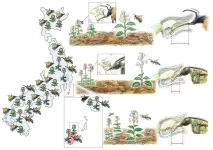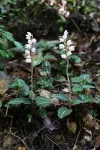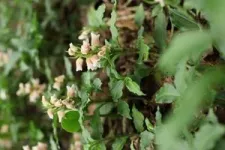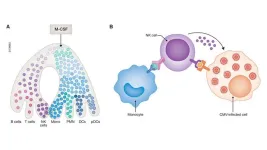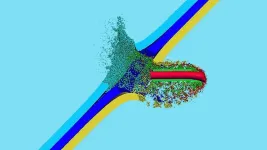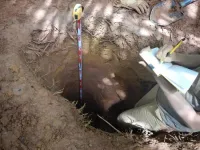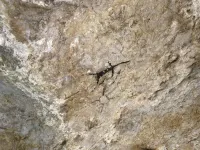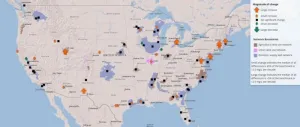(Press-News.org) Because the bumblebee that an orchid relies on for pollination does not exist on a remote island, the plant gets pollinated by an island wasp. Kobe University researchers found that this came at the cost of being hybridized with another orchid species adapted to being pollinated by the wasp. The finding showcases how plants in ecological relationships adapt to changing circumstances.
Remote islands have been exciting study grounds for biologists since at least the days of Darwin. When studying ecological relationships between different species, the differences between mainland and island can hint at how such relationships evolve and what this means for the participating species. This is what piqued plant scientists’ curiosity when they discovered Goodyera henryi, an orchid which on mainland Japan is pollinated exclusively by a very specific bumblebee, on remote Japanese Kozu Island where the bumblebee doesn’t exist.
For Kobe University Professor SUETSUGU Kenji this fit perfectly into his long-term effort to understand the dynamics of island biology and evolutionary processes. The orchid specialist says: “The combination of our expertise, access to the location, and our interdisciplinary methodology puts us in a special position to study the impact of bumblebee absence on orchid evolution in this context.” With his team he studied the pollination of the orchids both on mainland Japan and on Kozu Island, and also employed genetic analysis to learn about the relationship patterns between the different populations of the plants.
The results, now published in the journal New Phytologist, came with a surprise. The researchers first noticed that, on Kozu Island, Goodyera henryi is pollinated by the same scoliid wasp as the closely related orchid Goodyera similis, also found on the island. While in orchids the length of the flower tube closely matches the length of the pollinating insect mouthparts, the island wasp has much shorter mouthparts than the bumblebee that pollinates Goodyera henryi on the mainland. The researchers also noticed that the orchid’s flower tube was shorter on the island than the mainland. The surprise came when they compared the genetic makeup of the orchids. Suetsugu explains: “All specimens initially categorized as Goodyera henryi on Kozu Island are hybrids, leading to the absence of the pure species on the island.”
The research team speculate that, when Goodyera henryi first arrived on the island, it must have been visited by a wasp by chance, or precisely because the plant was not being visited by the bumblebee. While the wasp’s mouthparts are shorter than the bumblebee’s and therefore unable to carry Goodyera henryi pollen from one flower to another, if the insect had just before visited its usual orchid, Goodyera simils, pollen from that plant might have ended up on the new arrival, hybridizing it. This changed the appearance of the orchid such that it was now able to attach pollen to its substitute pollinator and thus establish itself on the island in its new hybridized form. “The most exciting aspect of this result is probably the implication for our understanding of how plants can adapt and evolve in response to changing ecological conditions, particularly in the context of declining pollinator populations,” says the Kobe University researcher.
Suetsugu says that this has implications beyond the academic study of evolutionary dynamics. Bumblebee species are on a global decline, but because bee removal experiments are unethical and impractical, it has been difficult to predict the ecological consequences. Explaining what the newly published results mean he says, “Even if bumblebee-dependent plants successfully engage substitute pollinators amidst the global decline of long-tongued bumblebees, the maintenance of plants’ species boundaries could be compromised due to the sharing of pollinators via hybrid formation.”
This study was financially supported by the Japan Science and Technology Agency (PRESTO JPMJPR21D6), by the Ministry of Environment, Japan (Environment Research and Technology Development Fund #4-2001), by the Ichimura Foundation for New Technology (26-01 and 27-7), and by the MEXT Promotion of Distinctive Joint Research Center Program (JPMXP0622716984). It was conducted in collaboration with researchers from Tohoku University, the Forestry and Forest Products Research Institute, the Museum of Natural and Environmental History Shizuoka, Kokubunji High School and from the Kozu Island village.
Kobe University is a national university with roots dating back to the Kobe Commercial School founded in 1902. It is now one of Japan's leading comprehensive research universities with nearly 16,000 students and nearly 1,700 faculty in 10 faculties and schools and 15 graduate schools. Combining the social and natural sciences to cultivate leaders with an interdisciplinary perspective, Kobe University creates knowledge and fosters innovation to address society’s challenges.
END
Orchid without bumblebee on island finds wasp, loses self
2023-10-17
ELSE PRESS RELEASES FROM THIS DATE:
Ocean circulation, ice melt and increasing tourism could all be contributing to Arctic microplastics
2023-10-17
Scientists measured microplastic concentrations in the highly productive Barents Sea and suggest that ocean circulation, ice melt, tourism, inadequate waste management, shipping and fishing are all likely contributors.
Numerous studies have shown that global microplastic quantities in the marine environment are increasing, even in remote locations such as the Arctic.
The Barents Sea, which adjoins the Arctic Ocean, is one of the most productive oceanic areas in the world and home to an enormous diversity of organisms.
It is also a key route for Atlantic ...
Boosting weak immune system: scientists find an unusual weapon against virus
2023-10-17
Some viruses can be dormant throughout a person’s life and cause no harm but become dangerous when the immune system is weakened. One of such viruses is human cytomegalovirus (CMV). Harmless to the general public but life-threatening to patients with a supressed immune system.
“Patients undergoing bone marrow transplantations have their blood and immune system fully replaced by that of the donor. In the first months after transplantation they are defenseless. They can either catch CMV or have virus reactivated that was dormant in the patient. At the moment, there is no ideal treatment. The available ones work ...
Depression, anxiety common among college students
2023-10-17
Depression and anxiety among college students is a growing public health problem. And new research from the University of Georgia suggests the problem may be worse for students who aren’t the same race as most of their peers.
The new study found that students who were not the majority race at a predominantly white college reported significantly higher rates of depression than their white peers.
At the mostly white university, more than half of the students who self-identified as races other than white reported feelings of mild depression. An additional 17% said they were experiencing moderate to severe depression.
Students at the predominantly ...
Research finds water quality in Gulf of Mexico improves when adding social costs to carbon emissions
2023-10-17
DURHAM, N.H.—U.S. Climate policies can offer options for putting climate change efforts into place that solve environmental problems like excessive carbon dioxide in the atmosphere created by greenhouse gas emissions. Research led by the University of New Hampshire took a closer look at what would happen to agriculture if there was an extra cost, or so-called social cost, added to fossil fuels, which are essential for making fertilizer used in farming. They found that while CO2 emissions would decline by as much as 50%, the cost of fertilizer would rise leading to a significant benefit on water quality by lessening fertilizer runoff contributing ...
Mitigating electrode-level heterogeneity using phosphorus nanolayers on graphite for fast-charging batteries
2023-10-17
In a major stride towards achieving fast-charging lithium-ion batteries (LIBs) with reliable cyclability, researchers at UNIST have made a groundbreaking discovery. Their study, published in the prestigious ACS Energy Letters, introduces a novel strategy of utilizing phosphorus nanolayers to enhance the lithiation kinetics and performance of graphite-based composites, without compromising safety.
Led by Professor Hyun-Wook Lee from the School of Energy and Chemical Engineering at UNIST, the research team developed a revolutionary graphite-phosphorus composite using a vaporization-condensation ...
In 2020, 30% of the Pantanal was burned to cinders by wildfires
2023-10-17
In 2020, the Pantanal, the largest tropical freshwater wetland in the world and a biodiversity hotspot, was swept by high-intensity fires that destroyed native vegetation in an area totaling 44,998 square kilometers (km²), or about 30% of the Brazilian portion of the biome, which spans some 150,000 km². The estimate is presented in an article published in the science journal Fire.
The area destroyed by that year’s disastrous fires was far larger than had been thought, according to the article. ...
SwRI will advance impact modeling software for U.S. Army Corps of Engineers
2023-10-17
SAN ANTONIO — October 17, 2023 —Southwest Research Institute (SwRI) will continue advancing the Elastic Plastic Impact Computations (EPIC) dynamic finite-element code as part of an Other Transaction Prototype Agreement with the U.S Army Corps of Engineers. The first year’s funding of $500,000 has been awarded, with optional additional funding across the next three years totaling $3.5 million.
“EPIC uses finite element and particle methods to simulate complex impact and explosion scenarios,” said SwRI Staff Engineer Dr. Stephen Beissel, who leads the EPIC project and has been involved in EPIC’s development since the mid-1990s. ...
The earthworm effect: unraveling soil weathering dynamics
2023-10-17
17 October 2023
The Geological Society of America
Release No. 23-42
Contact: Justin Samuel
+1-303-357-1026
jsamuel@geosociety.org
For Immediate Release
Contributed by Sarah Derouin
Pittsburgh, Pa., USA: Earthworms, the hardworking invertebrates that grace the upper layers of soil, have long been considered helpful in our home gardens. Earthworms are prolific munchers, grinding up organic material and sediment grains that make up soils. Although they are very different animals, worms, like many poultry, have gizzards. “Worms will ingest some larger soil grains, and then they use the strongest and largest of those grains, retaining them in their gizzard,” ...
New dating of cave art reveals history of Puerto Rican people
2023-10-17
17 October 2023
The Geological Society of America
Release No. 23-40
Contact: Justin Samuel
+1-303-357-1026
jsamuel@geosociety.org
For Immediate Release
Leer en español.
Contributed by Sarah Derouin
Pittsburgh, Pa., USA: In the karstic caves of Puerto Rico, cave art paints the rock walls. Previous research has assigned ages to this art based on the ages of nearby archaeological artifacts within the caves, but these ages are relative and may not reflect the true timing of the art creation.
Now, a new study to be presented Wednesday at the Geological Society of America’s GSA Connects 2023 meeting shows that researchers have refined the age of this rupestrian ...
U.S. groundwater is getting saltier—what that means for infrastructure, ecosystems, and human health
2023-10-17
17 October 2023
The Geological Society of America
Release No. 23-41
Contact: Justin Samuel
+1-303-357-1026
jsamuel@geosociety.org
For Immediate Release
Contributed by Sarah Derouin
Pittsburgh, Pa., USA: Scientists from the U.S. Geological Survey (USGS) have been monitoring groundwater quality in wells across the country for more than three decades, looking for harmful chemicals or residual substances that may cause harm to ecosystems or humans. In all, they have measured up to 500 chemical constituents, including major ions, metals, pesticides, volatile organic compounds, fertilizers, and radionuclides.
Of ...
